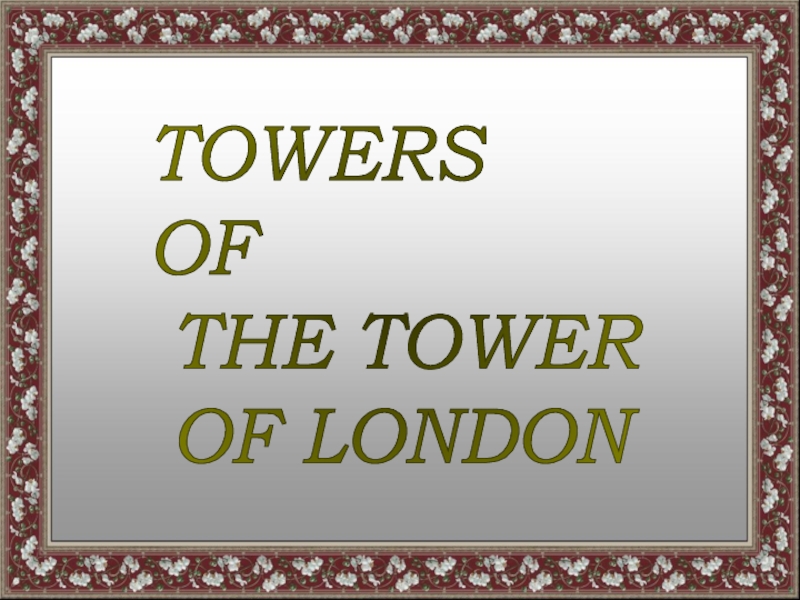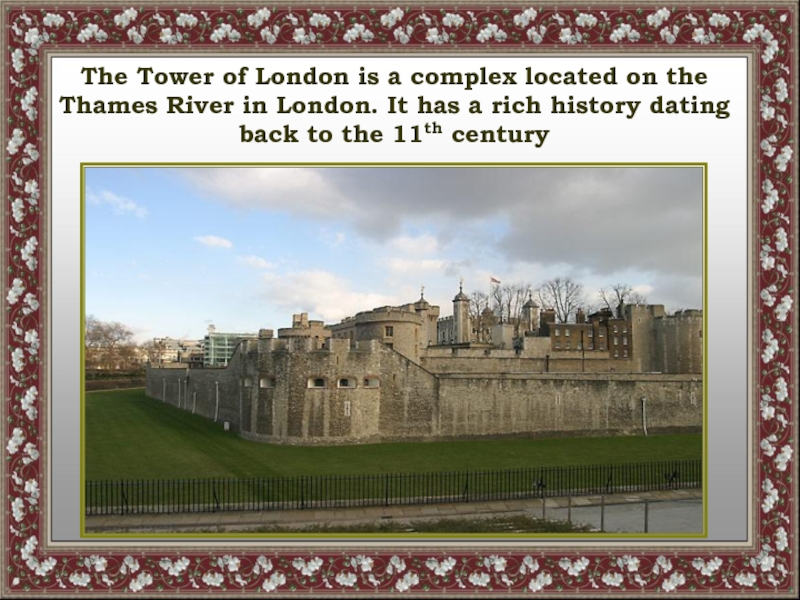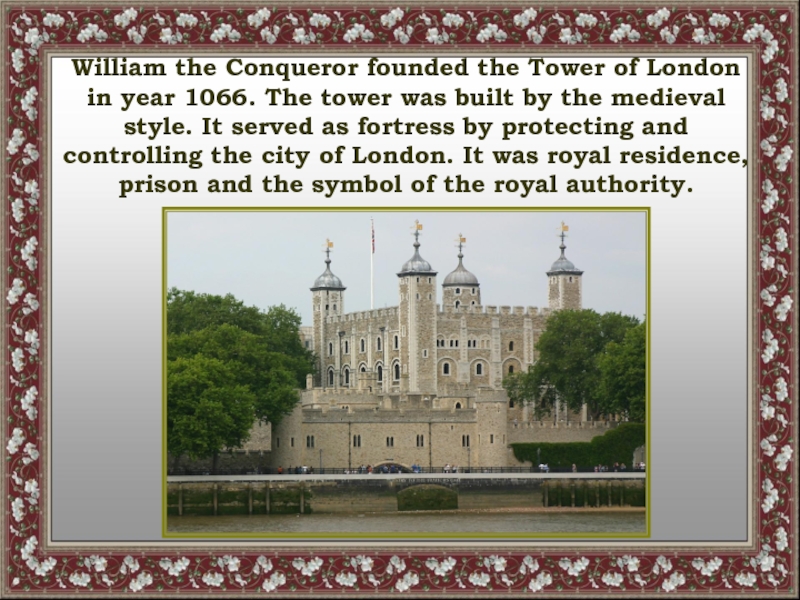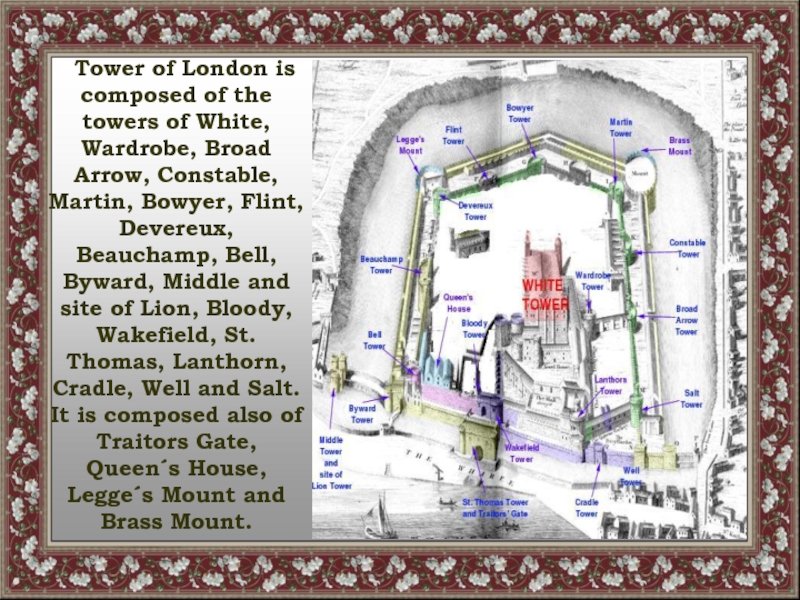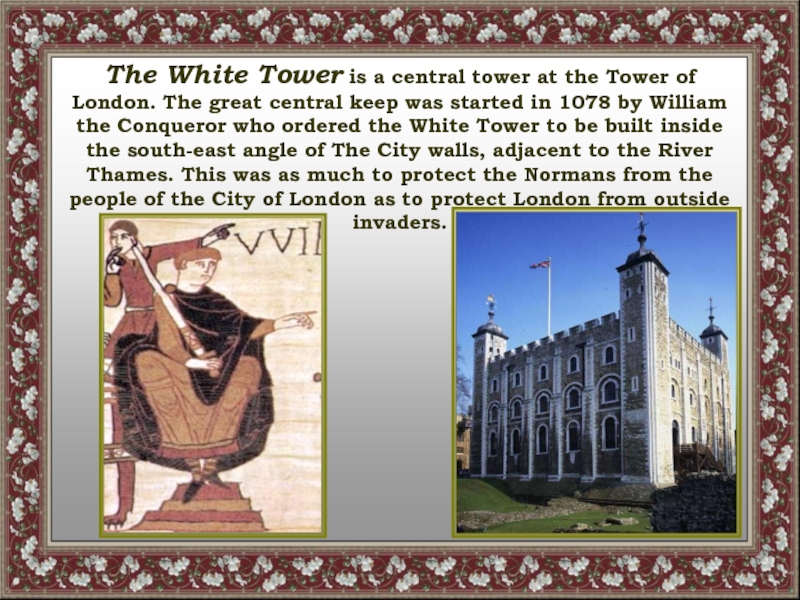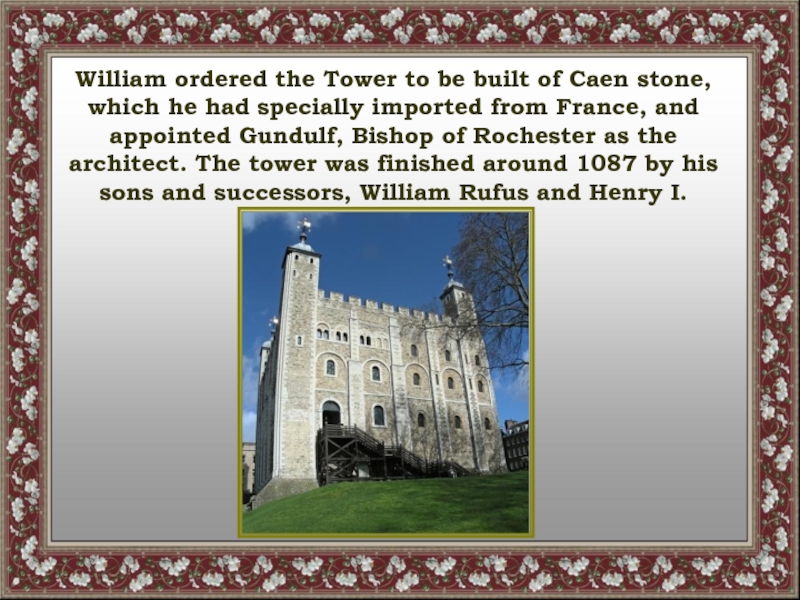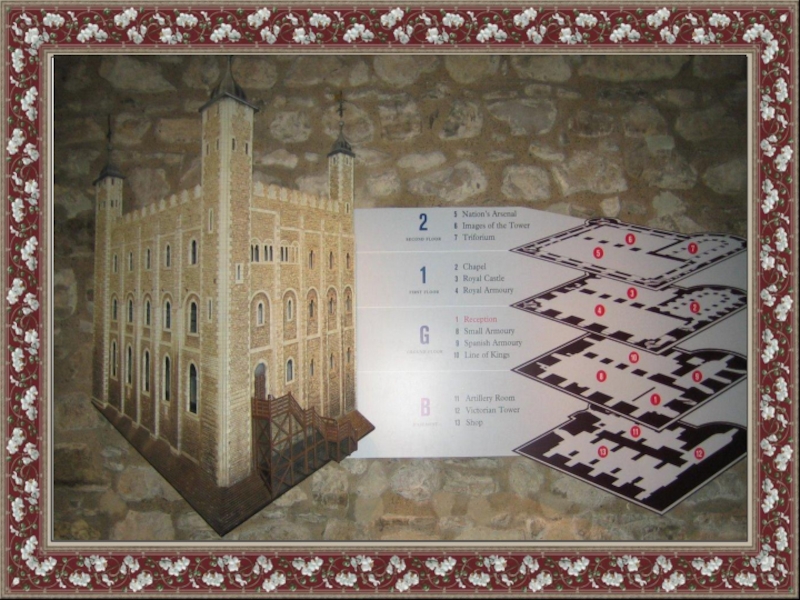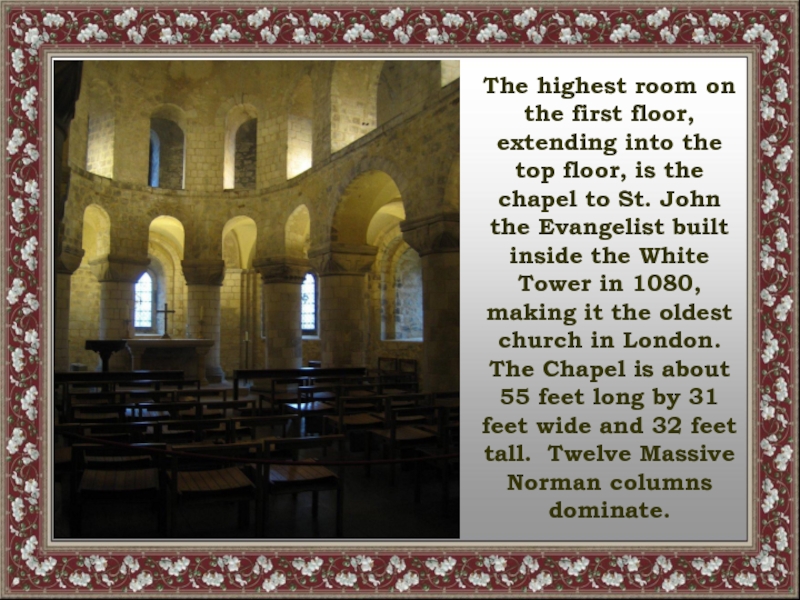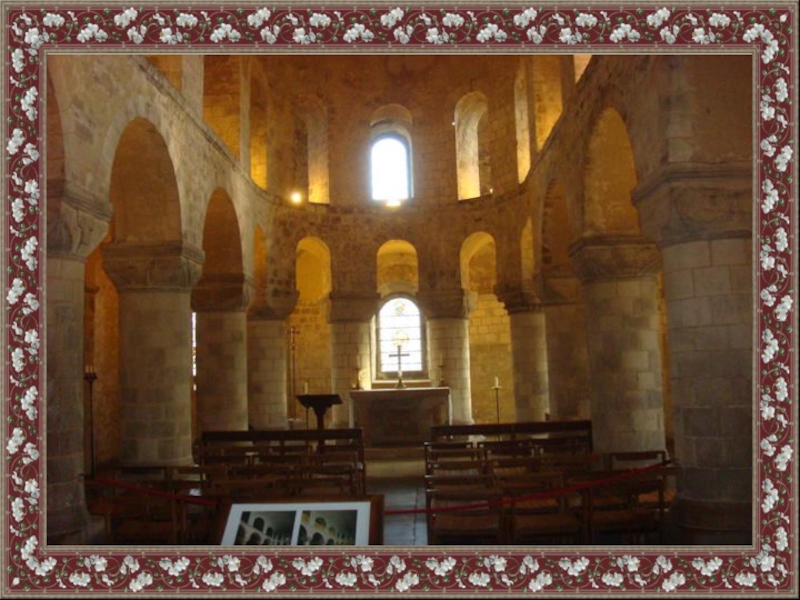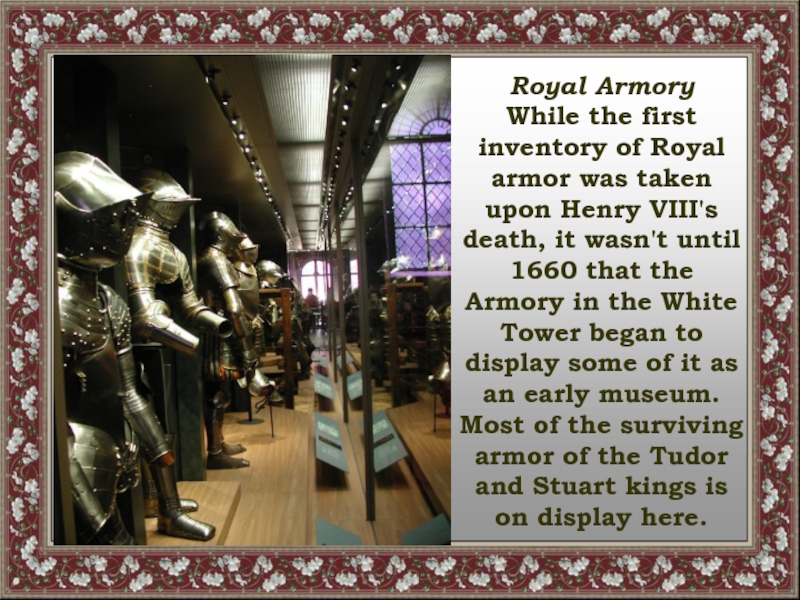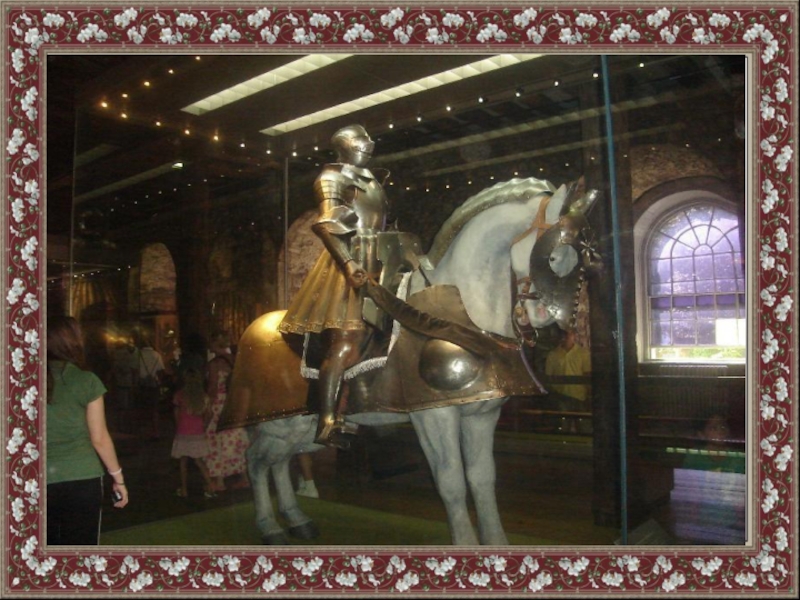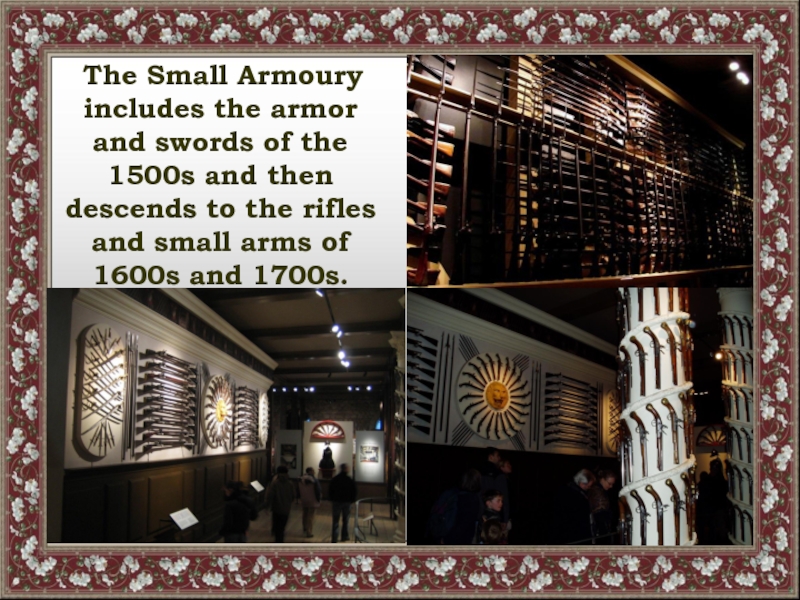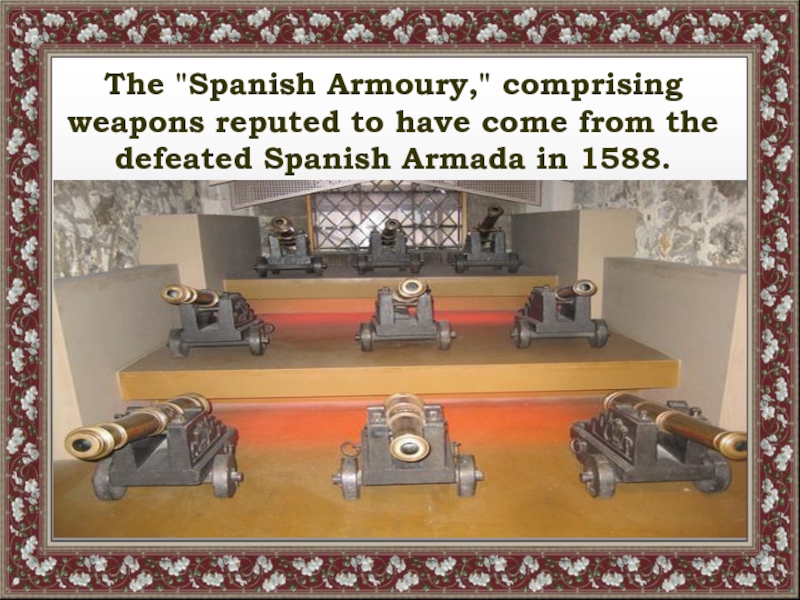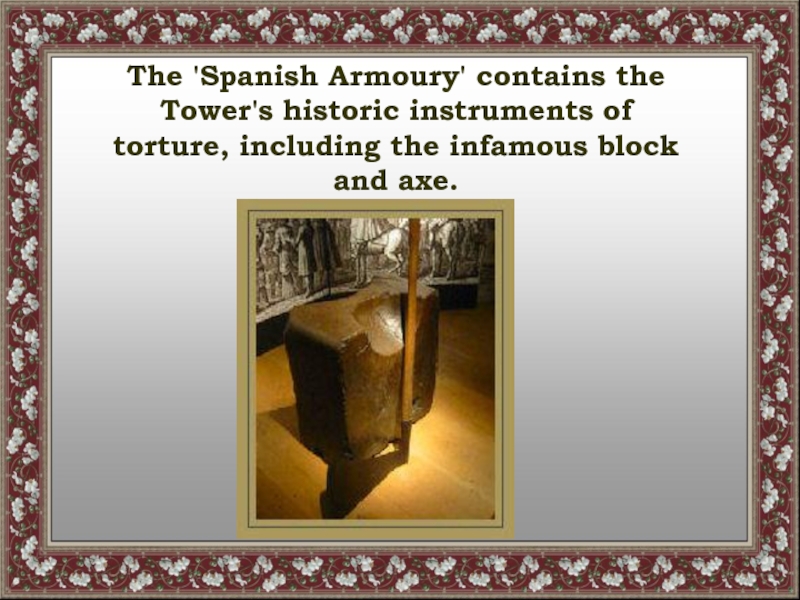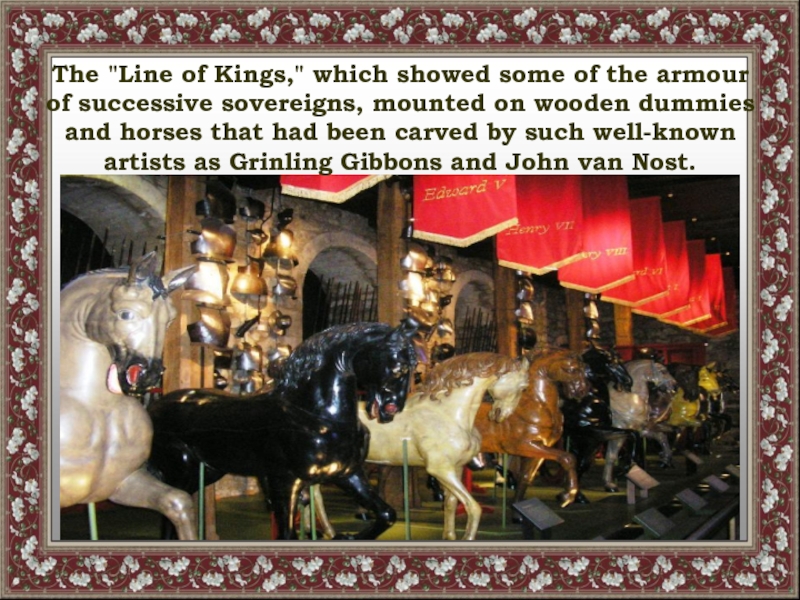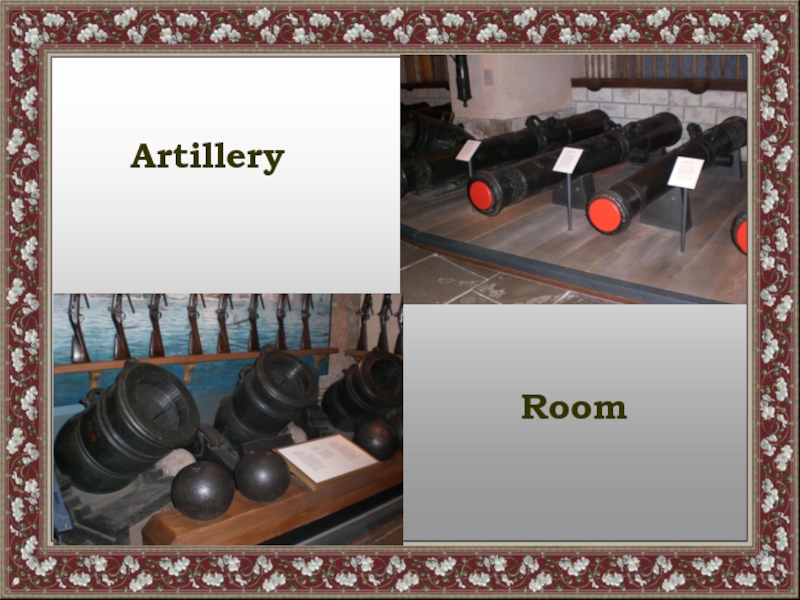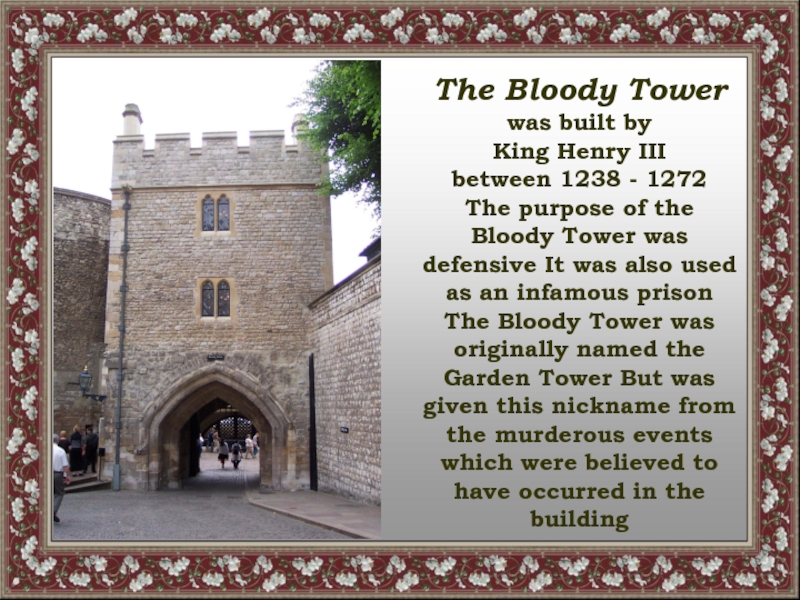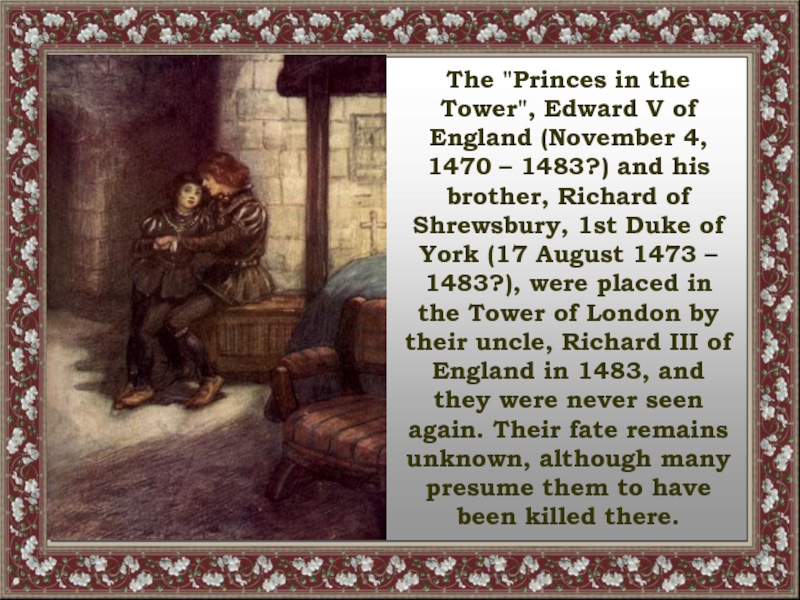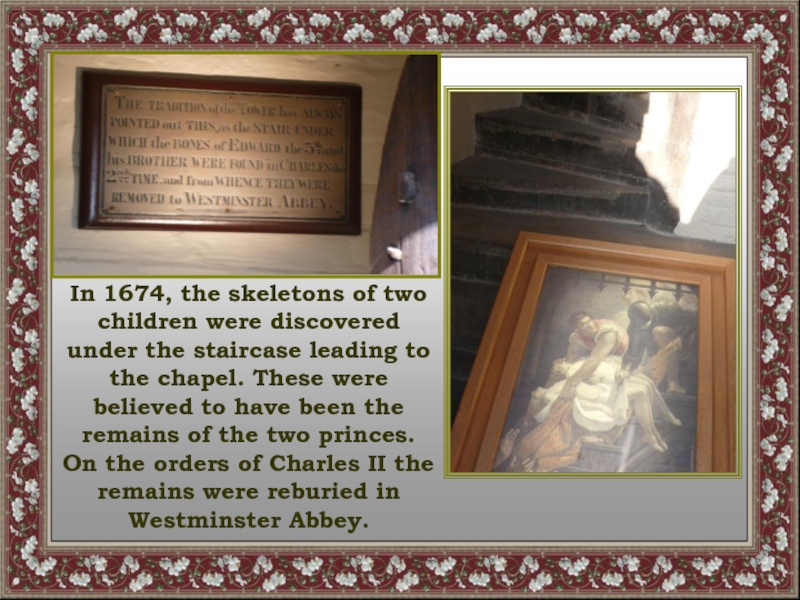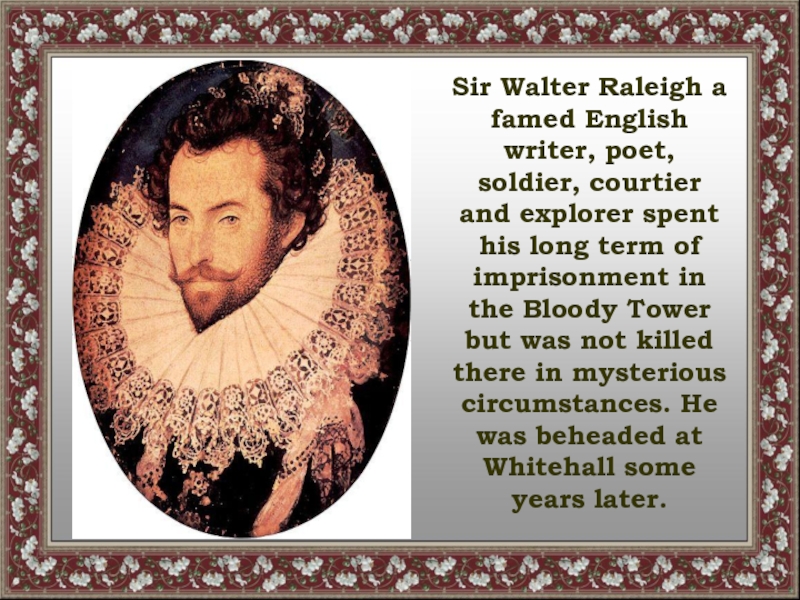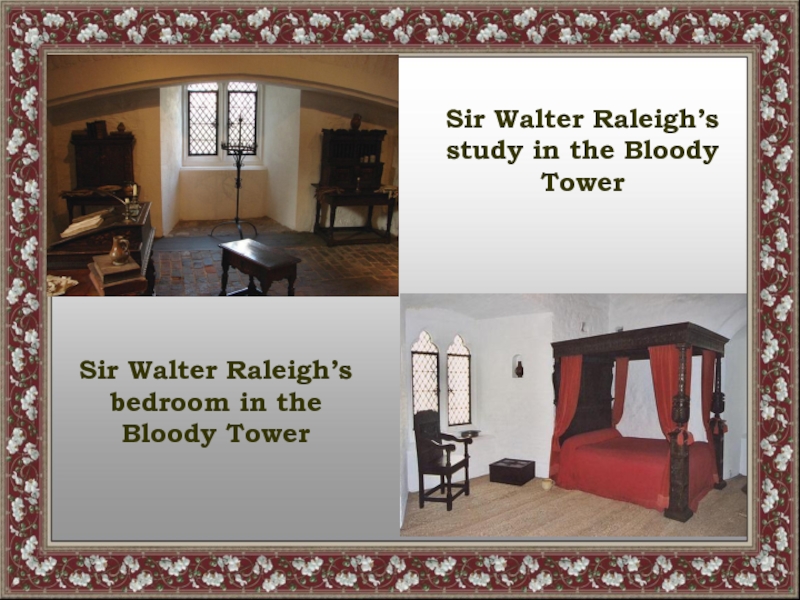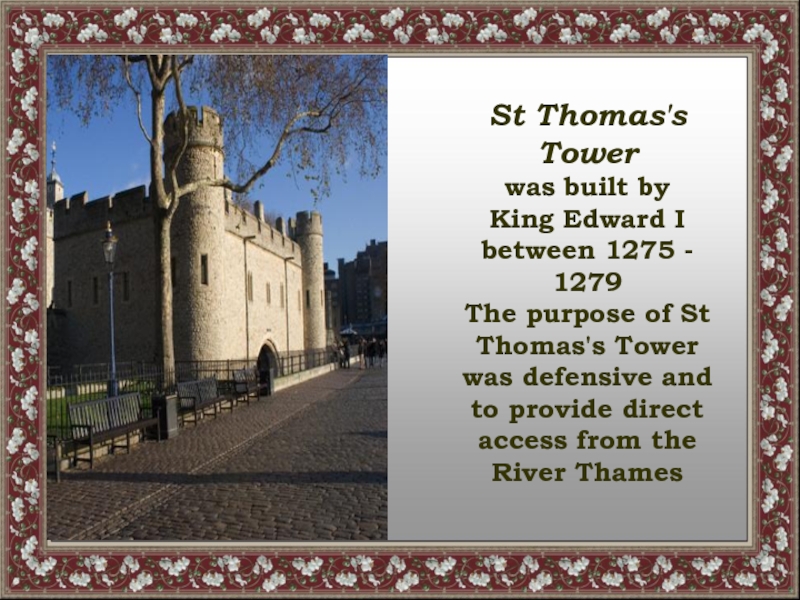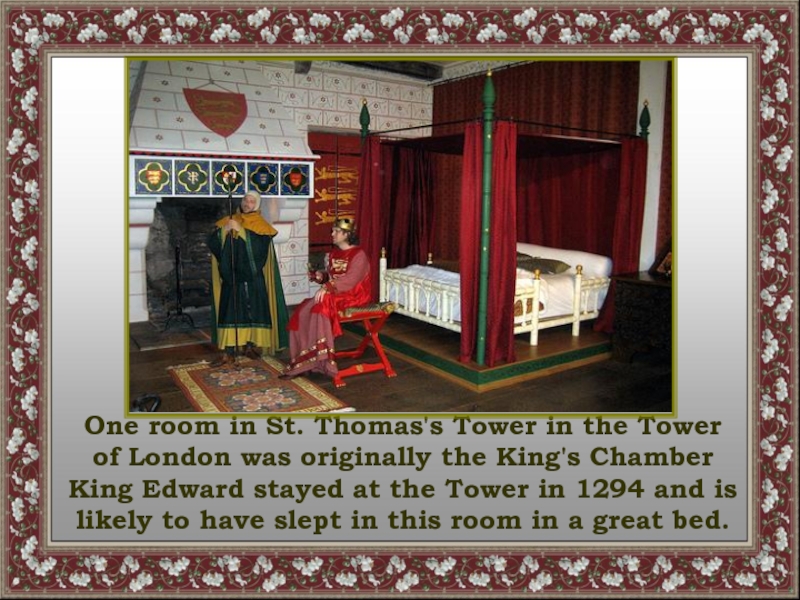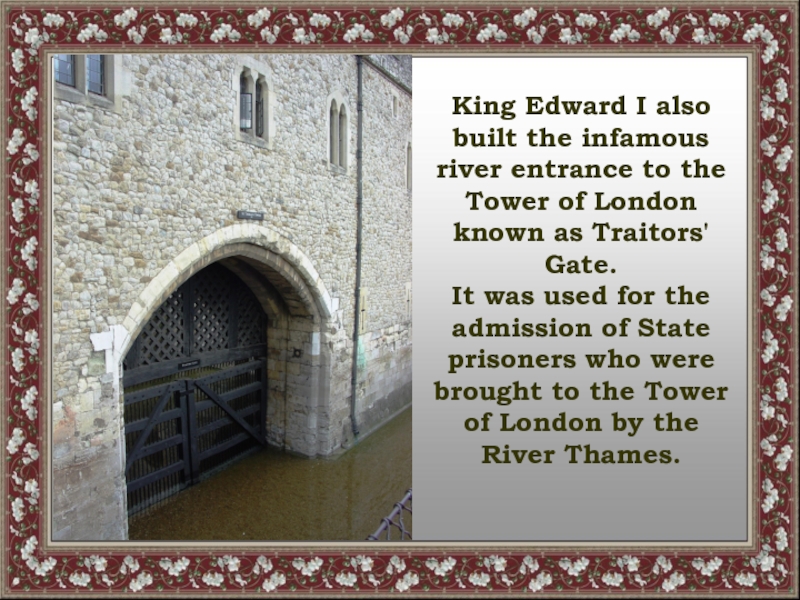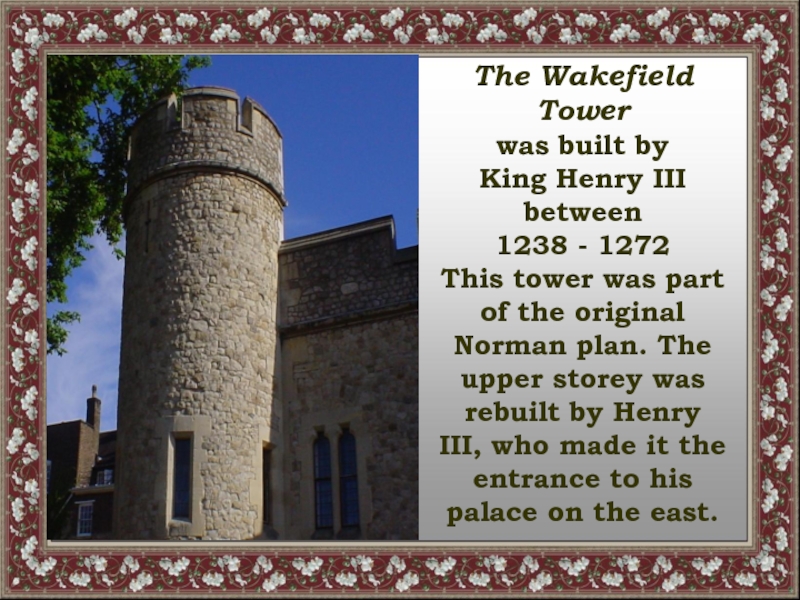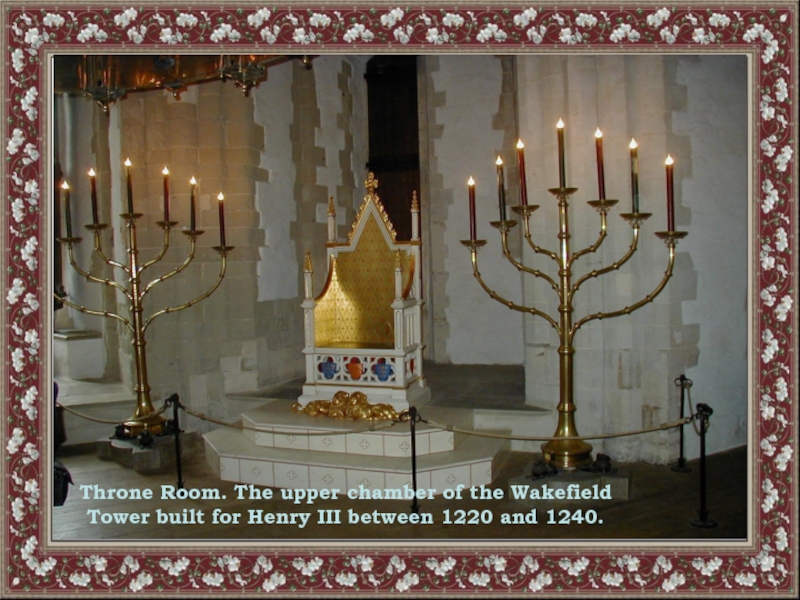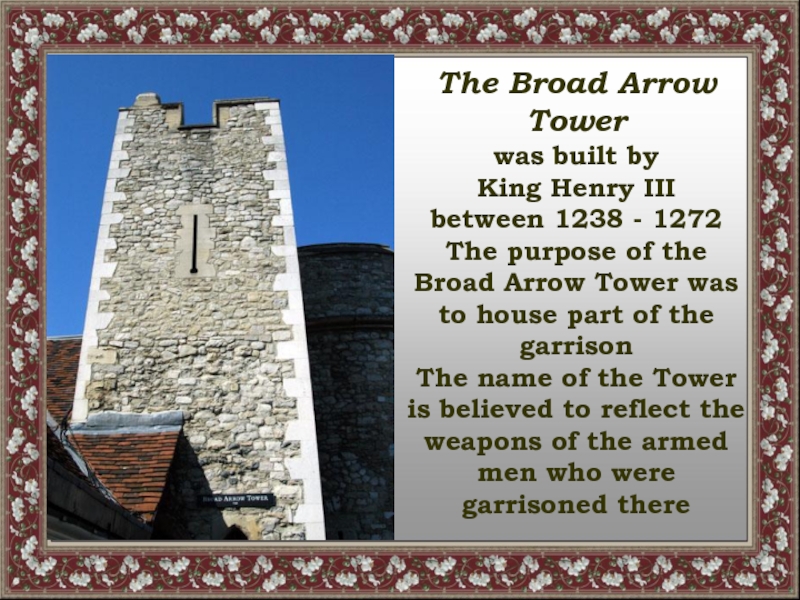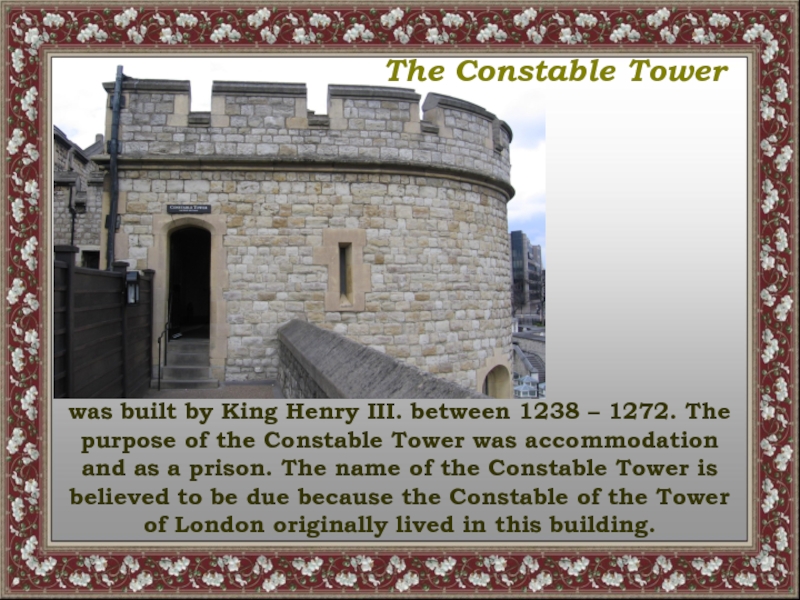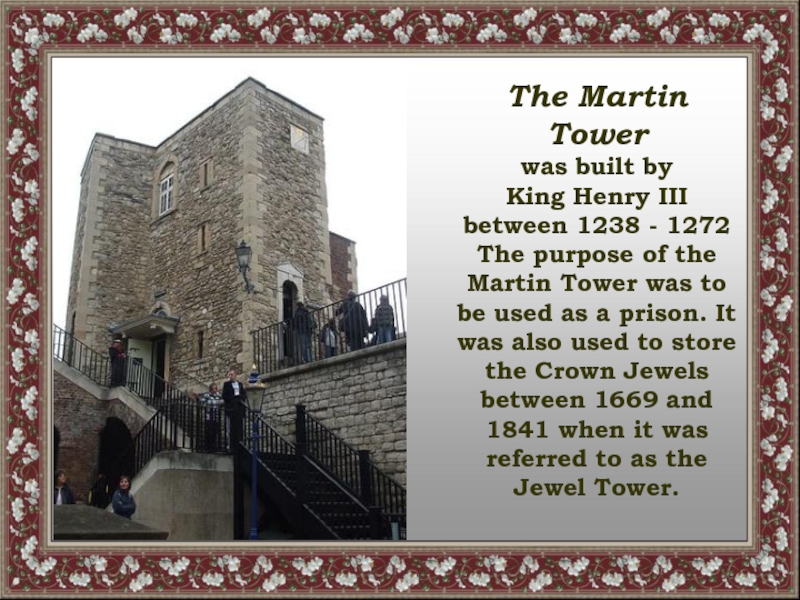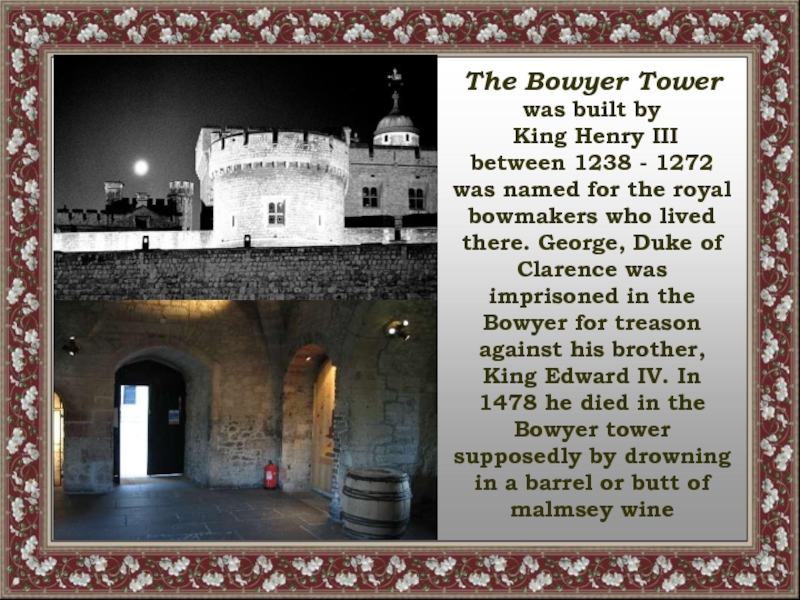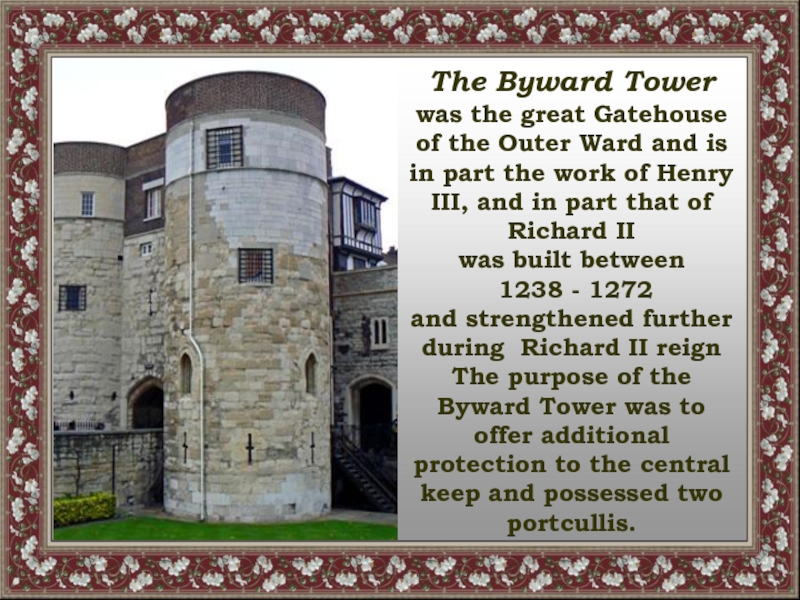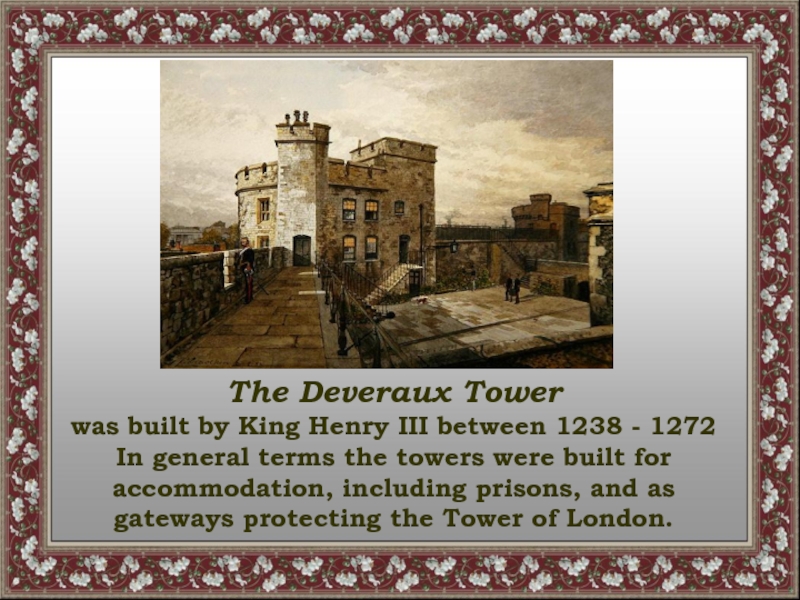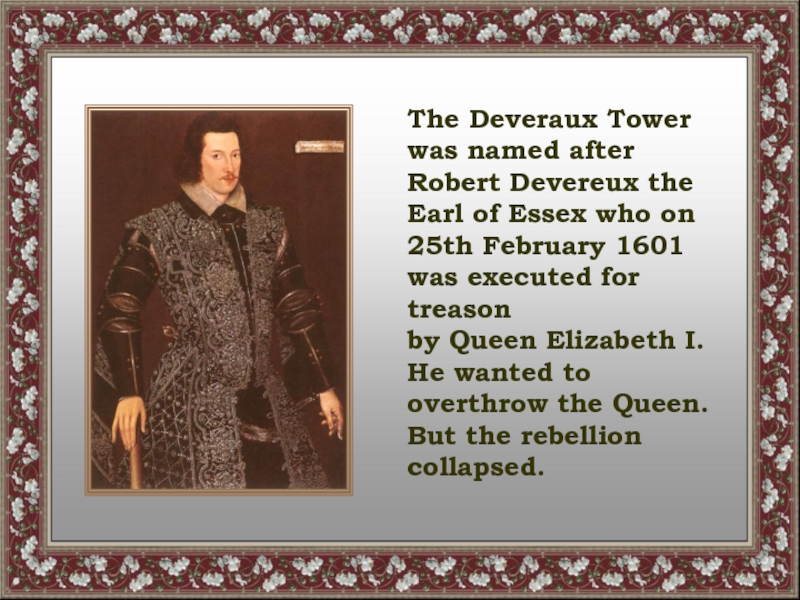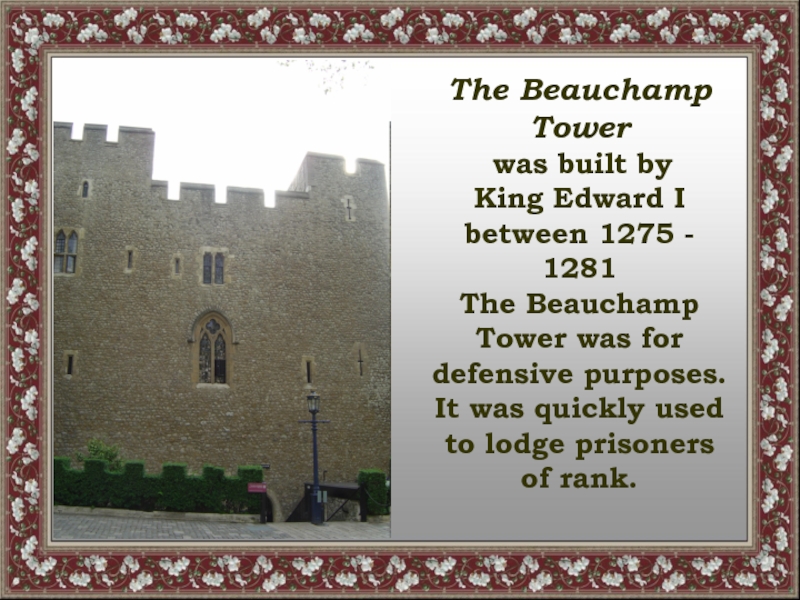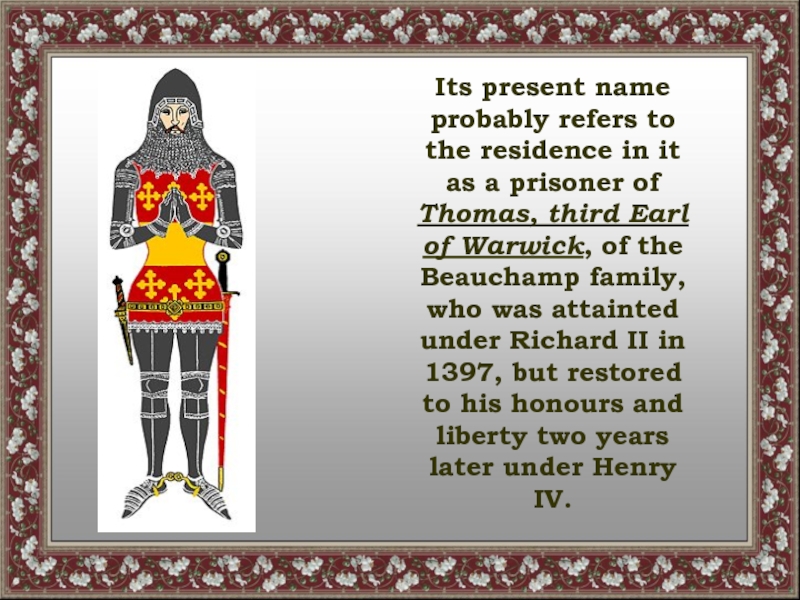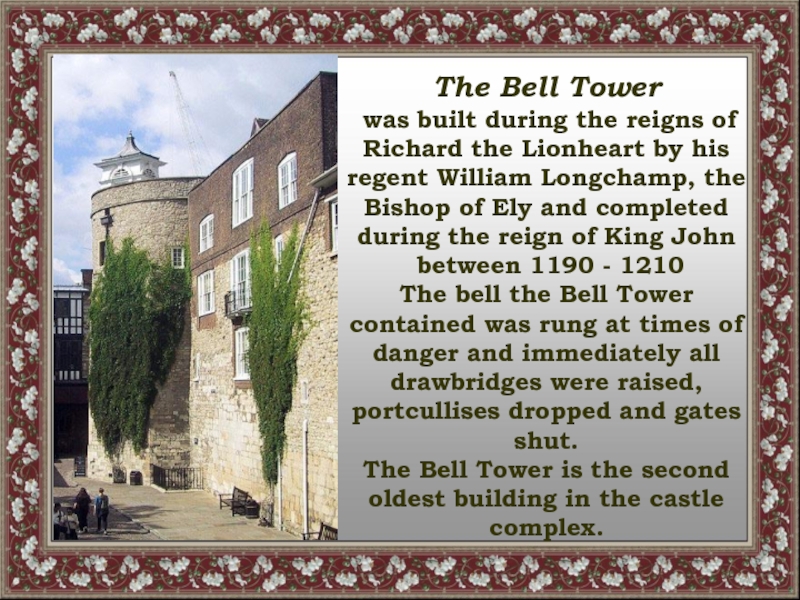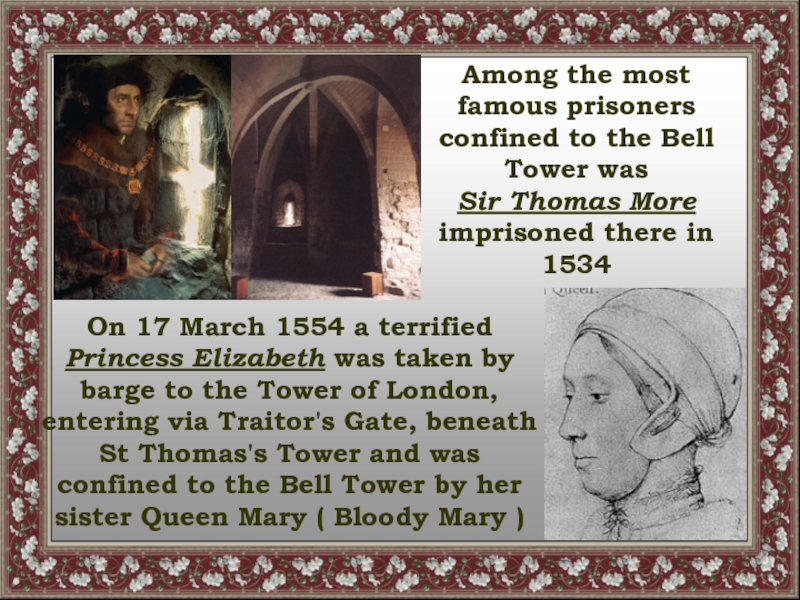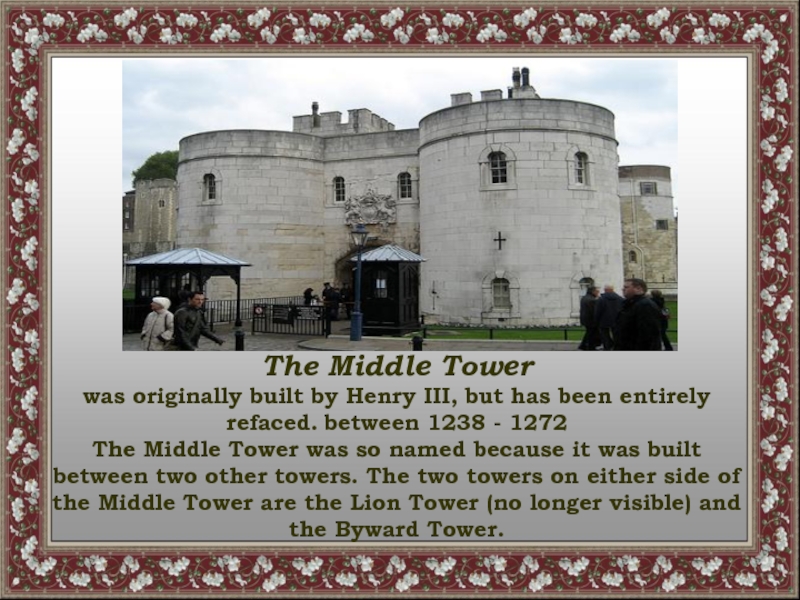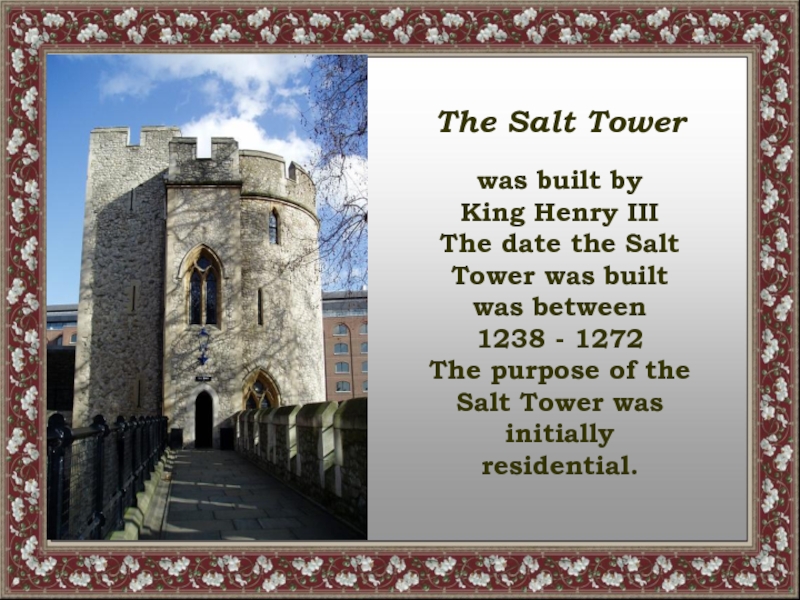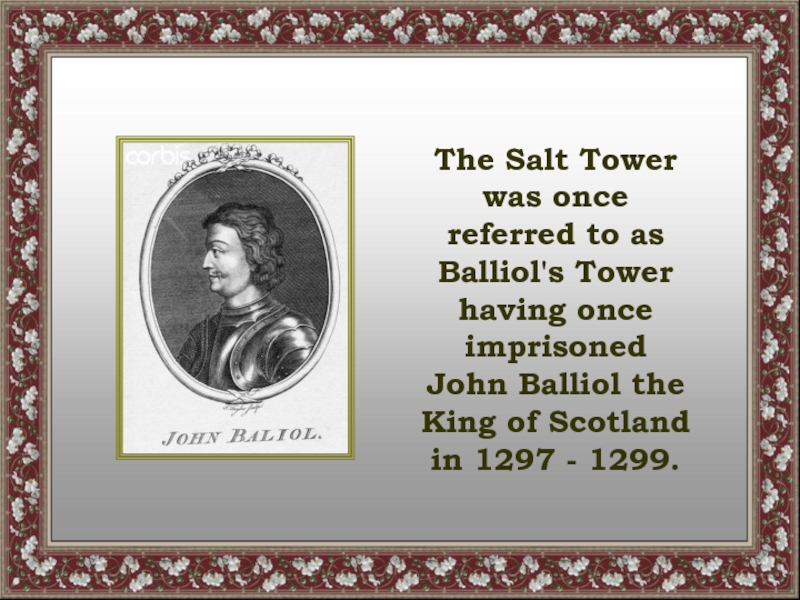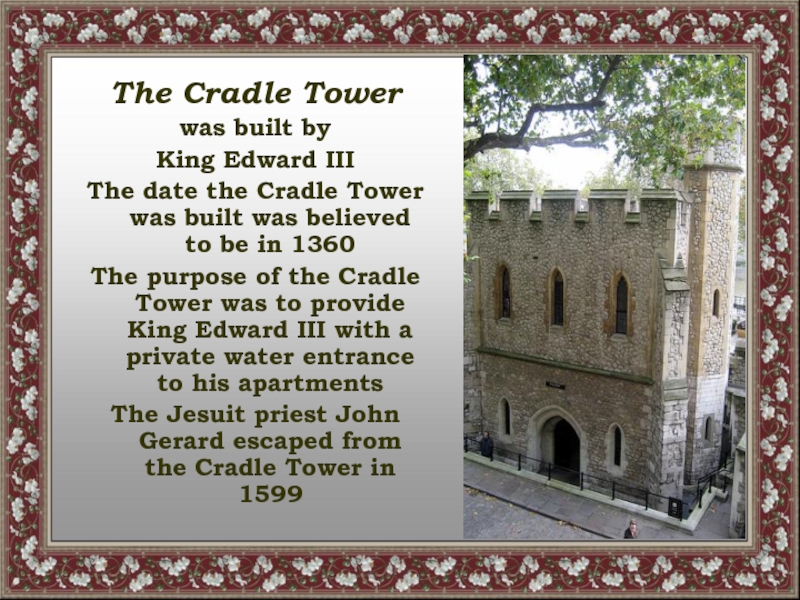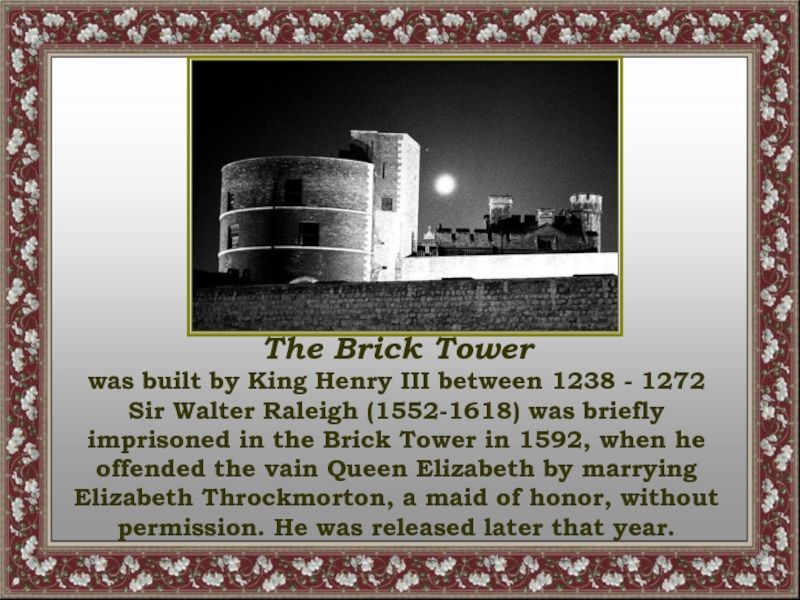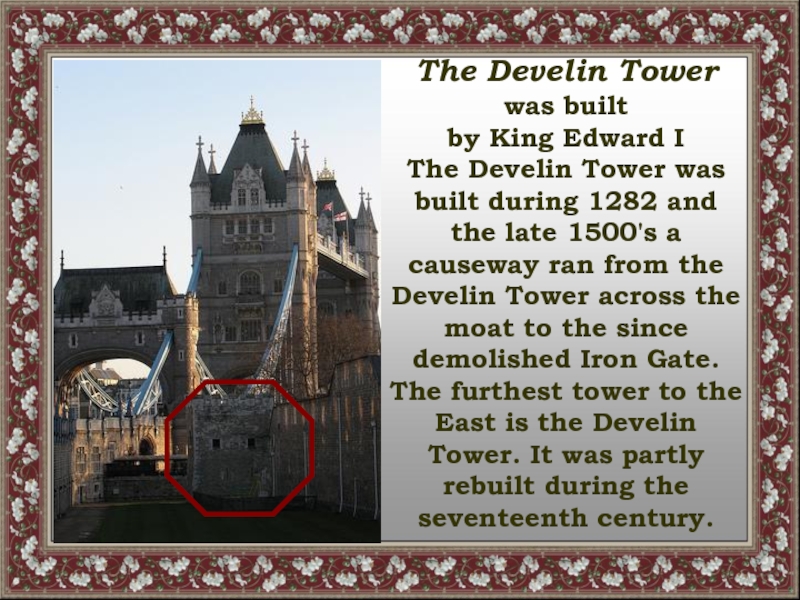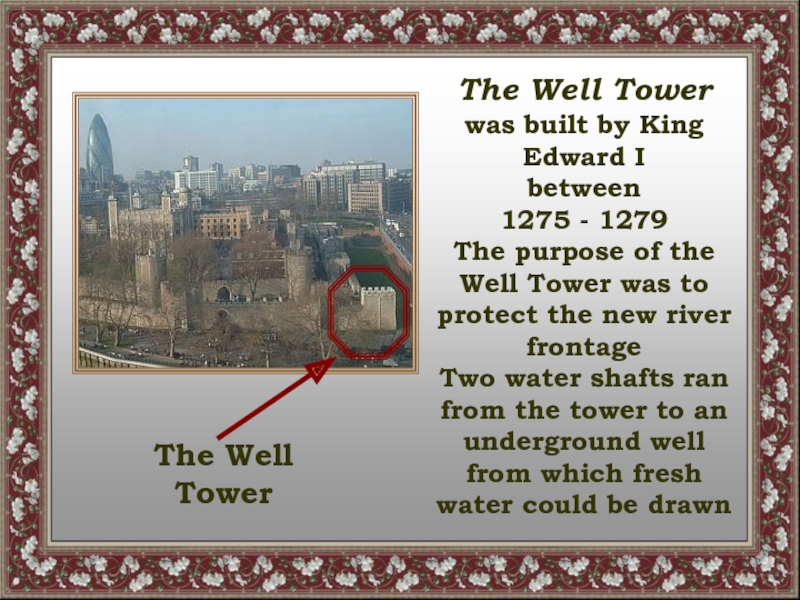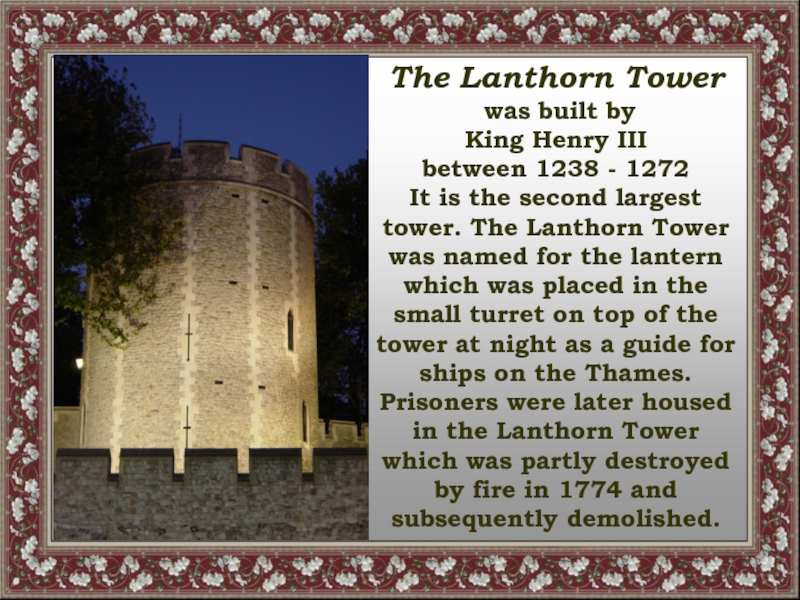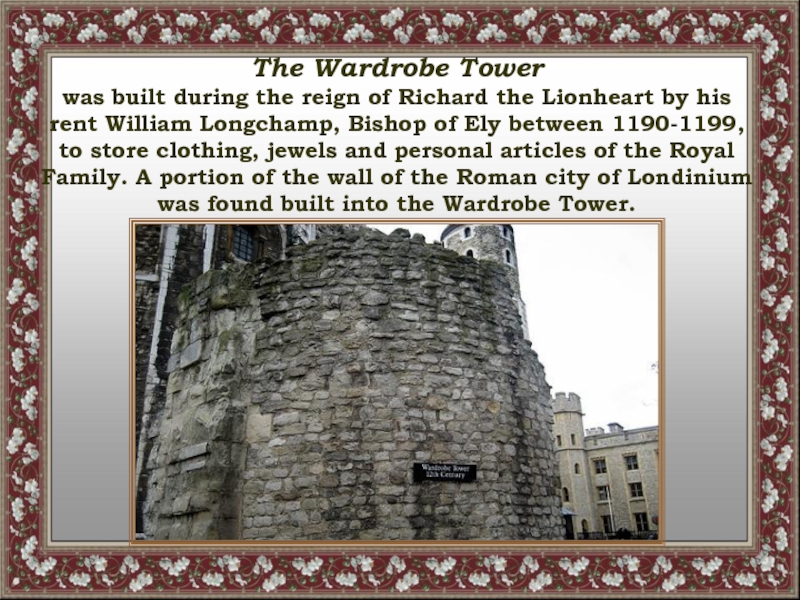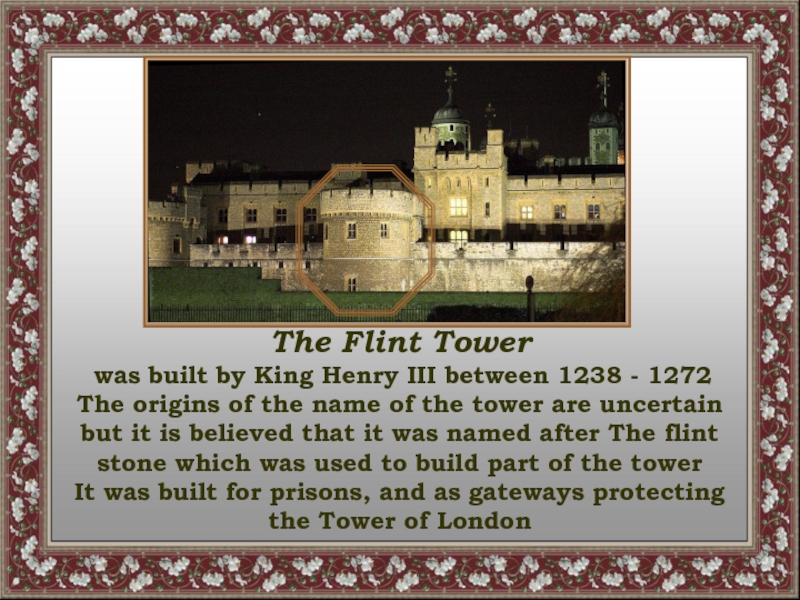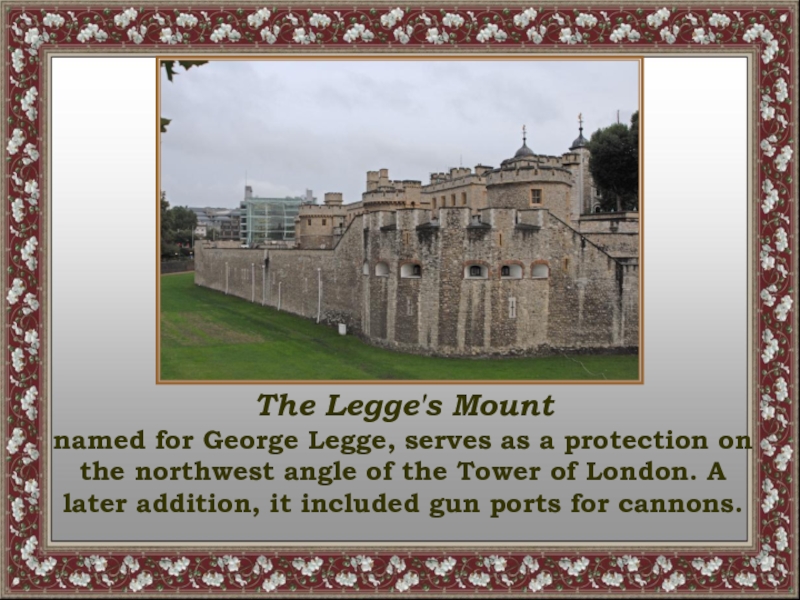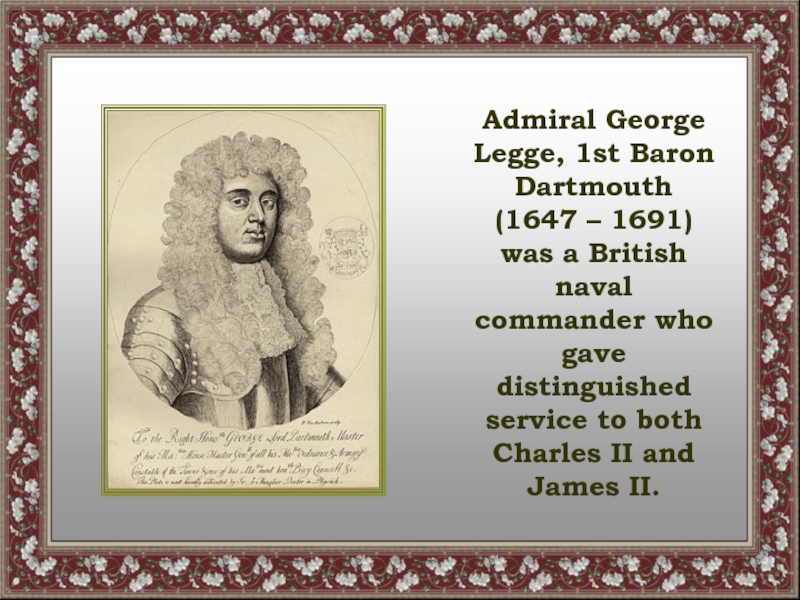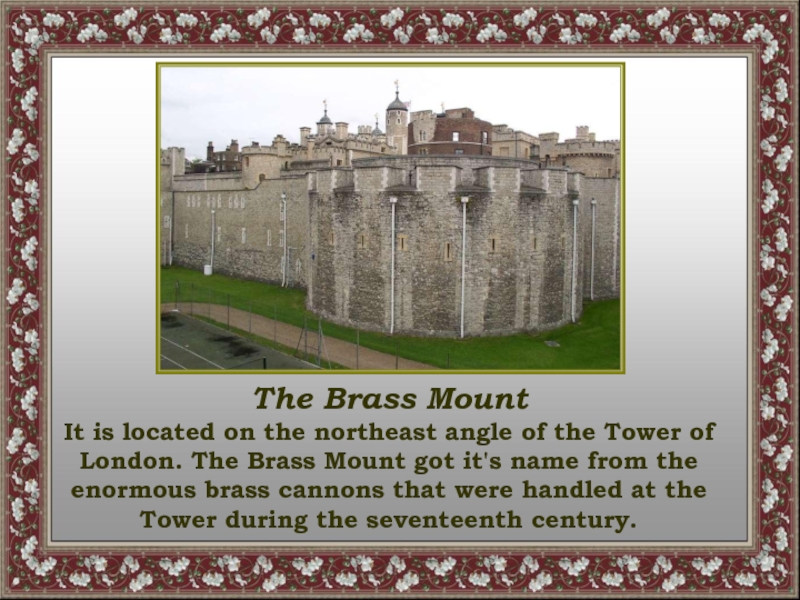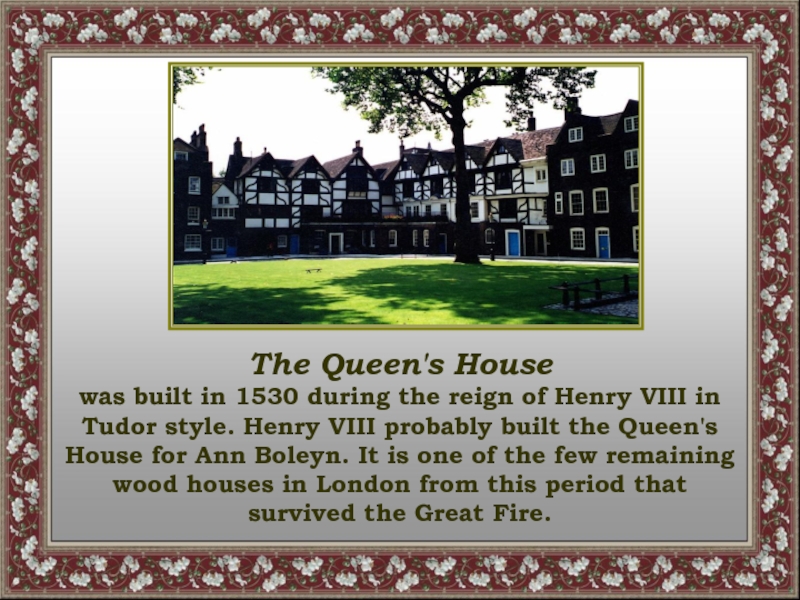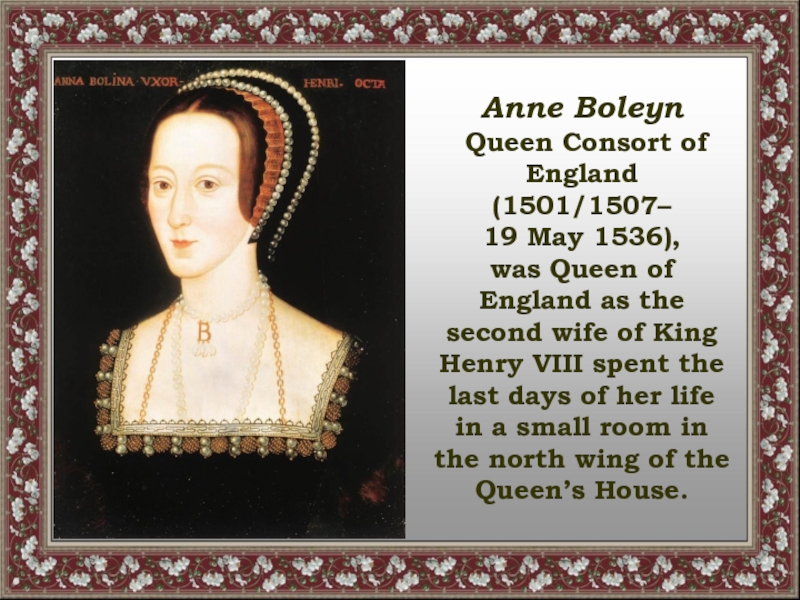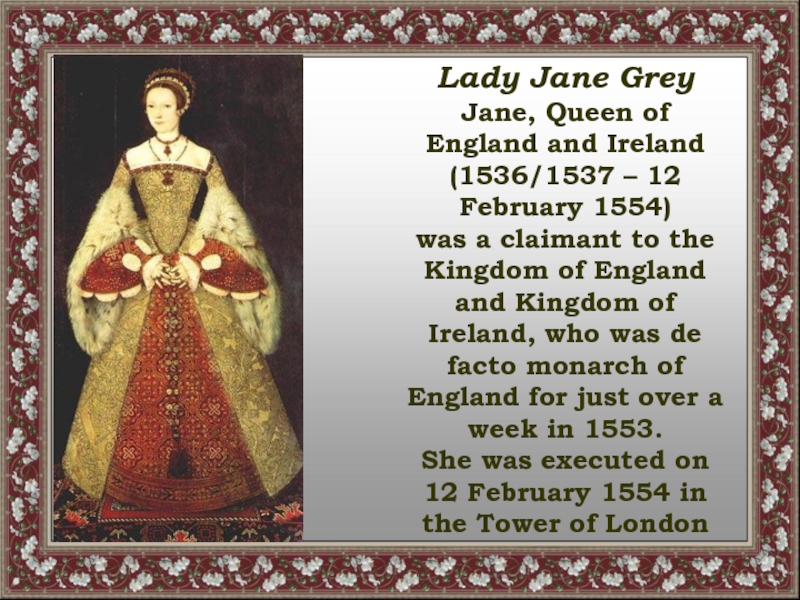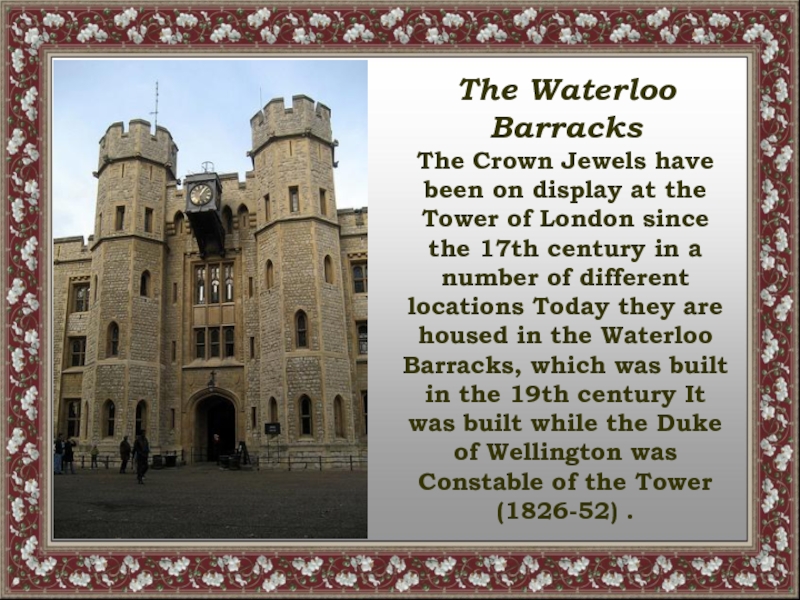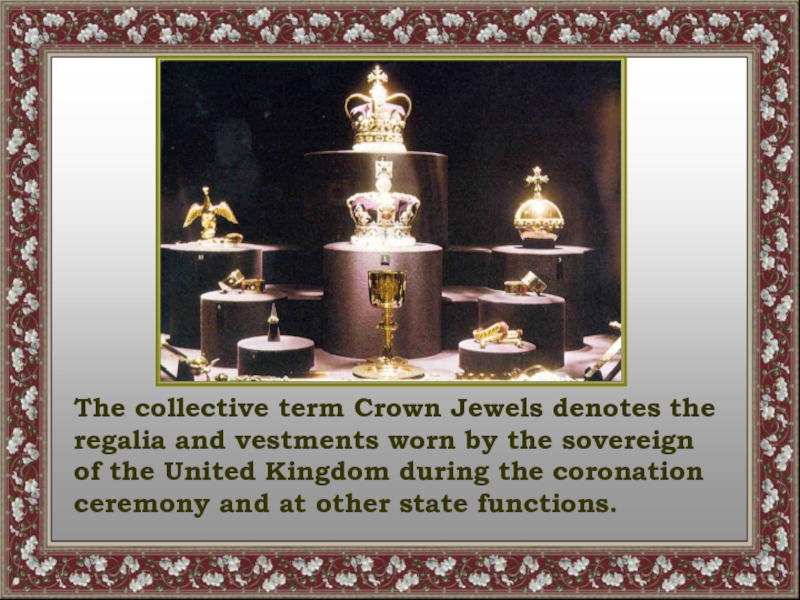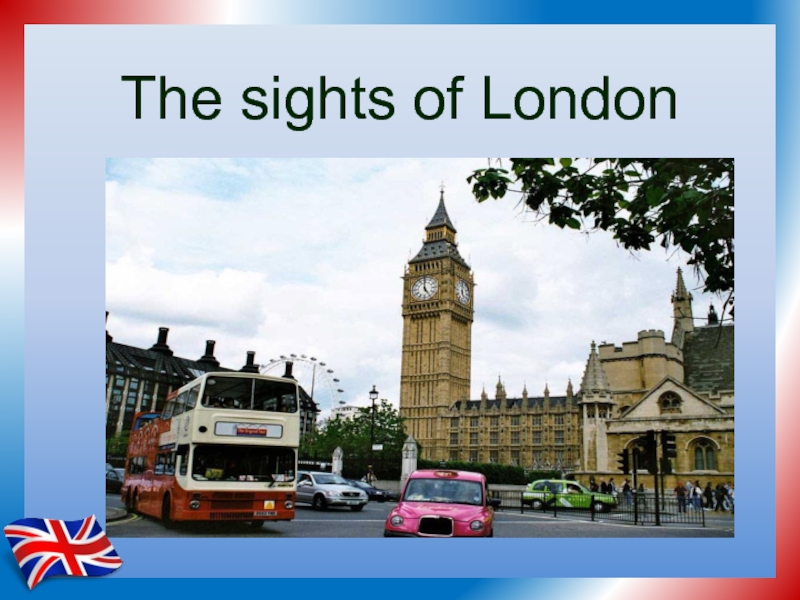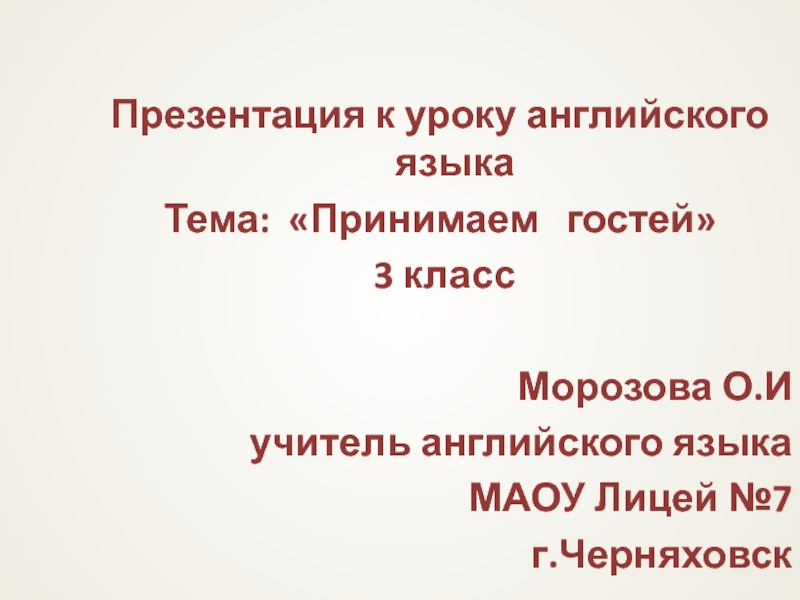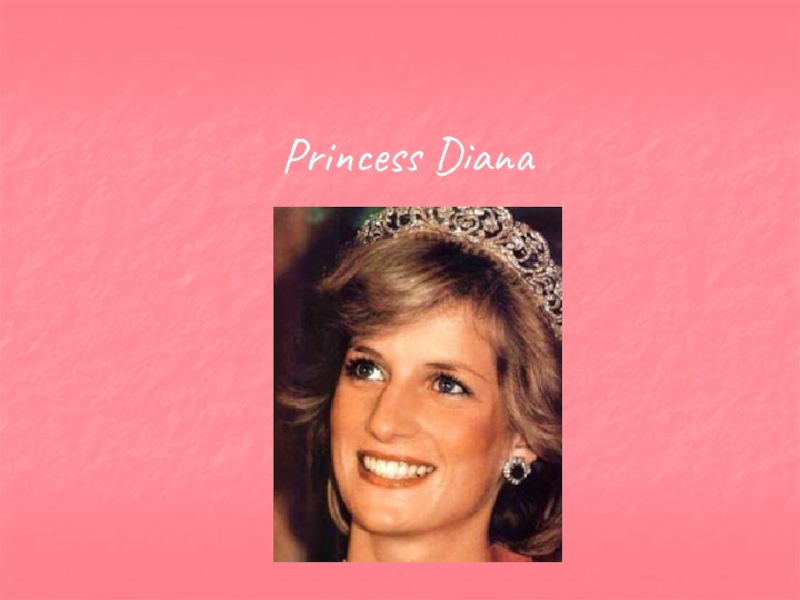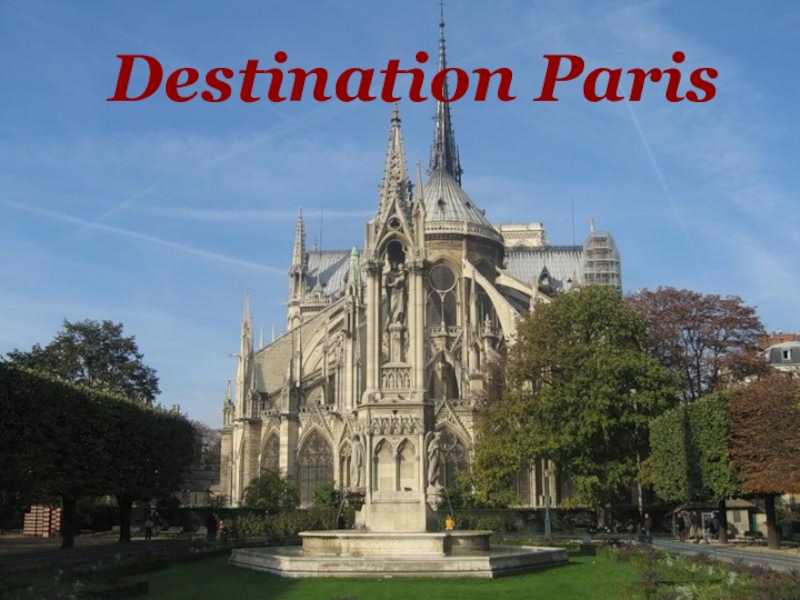Разделы презентаций
- Разное
- Английский язык
- Астрономия
- Алгебра
- Биология
- География
- Геометрия
- Детские презентации
- Информатика
- История
- Литература
- Математика
- Медицина
- Менеджмент
- Музыка
- МХК
- Немецкий язык
- ОБЖ
- Обществознание
- Окружающий мир
- Педагогика
- Русский язык
- Технология
- Физика
- Философия
- Химия
- Шаблоны, картинки для презентаций
- Экология
- Экономика
- Юриспруденция
Tower of London (презентация по английскому языку)
Содержание
- 1. Tower of London (презентация по английскому языку)
- 2. The Tower of London is a complex
- 3. William the Conqueror founded the Tower of
- 4. Tower of London is composed
- 5. The White Tower is a central tower
- 6. William ordered the Tower to be built
- 7. Слайд 7
- 8. The highest room on the first floor,
- 9. Слайд 9
- 10. Royal Armory While the first inventory of
- 11. Слайд 11
- 12. The Small Armoury includes the armor
- 13. The "Spanish Armoury," comprising weapons reputed to
- 14. The 'Spanish Armoury' contains the Tower's historic instruments of torture, including the infamous block and axe.
- 15. The "Line of Kings," which showed some
- 16. Artillery Room
- 17. The Bloody Tower was built by King
- 18. The "Princes in the Tower", Edward V
- 19. In 1674, the skeletons of two children
- 20. Sir Walter Raleigh a famed English writer,
- 21. Sir Walter Raleigh’s study in the Bloody TowerSir Walter Raleigh’s bedroom in the Bloody Tower
- 22. St Thomas's Tower was built by King
- 23. One room in St. Thomas's Tower in
- 24. King Edward I also built the infamous
- 25. The Wakefield Tower was built by King
- 26. Throne Room. The upper chamber of the
- 27. The Broad Arrow Tower was built by
- 28. was built by King Henry III. between
- 29. The Martin Tower was built by King
- 30. The Bowyer Tower was built by King
- 31. The Byward Tower was the great Gatehouse
- 32. The Deveraux Towerwas built by King Henry
- 33. The Deveraux Tower was named after Robert
- 34. The Beauchamp Tower was built by King
- 35. Its present name probably refers to the
- 36. The Bell Tower was built during the
- 37. Among the most famous prisoners confined to
- 38. The Middle Tower was originally built by
- 39. The Salt Tower was built by King
- 40. The Salt Tower was once referred to
- 41. The Cradle Tower was built by King
- 42. The Brick Tower was built by King
- 43. The Develin Tower was built by King
- 44. The Well Tower was built by King
- 45. The Lanthorn Tower was built by King
- 46. The Wardrobe Tower was built during the
- 47. The Flint Tower was built by King
- 48. The Legge's Mountnamed for George Legge, serves
- 49. Admiral George Legge, 1st Baron Dartmouth
- 50. The Brass Mount It is located on
- 51. The Queen's Housewas built in 1530 during
- 52. Anne Boleyn Queen Consort of England (1501/1507–
- 53. Lady Jane GreyJane, Queen of England and
- 54. The Waterloo Barracks The Crown Jewels have
- 55. The collective term Crown Jewels denotes the
- 56. Источники:http://www.castles.me.uk/the-tower-of-london.htmhttp://ru.wikipedia.org/wiki/Заглавная_страницаhttp://архив картинок google.ruhttp://library.thinkquest.org/J0113146/towers_grounds.htm
- 57. Скачать презентанцию
Слайды и текст этой презентации
Слайд 3William the Conqueror founded the Tower of London in year
1066. The tower was built by the medieval style. It
served as fortress by protecting and controlling the city of London. It was royal residence, prison and the symbol of the royal authority.Слайд 4 Tower of London is composed of the towers
of White, Wardrobe, Broad Arrow, Constable, Martin, Bowyer, Flint, Devereux,
Beauchamp, Bell, Byward, Middle and site of Lion, Bloody, Wakefield, St. Thomas, Lanthorn, Cradle, Well and Salt. It is composed also of Traitors Gate, Queen´s House, Legge´s Mount and Brass Mount.Слайд 5The White Tower is a central tower at the Tower
of London. The great central keep was started in 1078
by William the Conqueror who ordered the White Tower to be built inside the south-east angle of The City walls, adjacent to the River Thames. This was as much to protect the Normans from the people of the City of London as to protect London from outside invaders.Слайд 6William ordered the Tower to be built of Caen stone,
which he had specially imported from France, and appointed Gundulf,
Bishop of Rochester as the architect. The tower was finished around 1087 by his sons and successors, William Rufus and Henry I.Слайд 8The highest room on the first floor, extending into the
top floor, is the chapel to St. John the Evangelist
built inside the White Tower in 1080, making it the oldest church in London.The Chapel is about 55 feet long by 31 feet wide and 32 feet tall. Twelve Massive Norman columns dominate.
Слайд 10Royal Armory
While the first inventory of Royal armor was
taken upon Henry VIII's death, it wasn't until 1660 that
the Armory in the White Tower began to display some of it as an early museum. Most of the surviving armor of the Tudor and Stuart kings is on display here.Слайд 12 The Small Armoury includes the armor and swords of
the 1500s and then descends to the rifles and small
arms of 1600s and 1700s.Слайд 13The "Spanish Armoury," comprising weapons reputed to have come from
the defeated Spanish Armada in 1588.
Слайд 14The 'Spanish Armoury' contains the Tower's historic instruments of torture,
including the infamous block and axe.
Слайд 15The "Line of Kings," which showed some of the armour
of successive sovereigns, mounted on wooden dummies and horses that
had been carved by such well-known artists as Grinling Gibbons and John van Nost.Слайд 17The Bloody Tower
was built by
King Henry III
between 1238
- 1272
The purpose of the Bloody Tower was defensive It
was also used as an infamous prisonThe Bloody Tower was originally named the Garden Tower But was given this nickname from the murderous events which were believed to have occurred in the building
Слайд 18The "Princes in the Tower", Edward V of England (November
4, 1470 – 1483?) and his brother, Richard of Shrewsbury,
1st Duke of York (17 August 1473 – 1483?), were placed in the Tower of London by their uncle, Richard III of England in 1483, and they were never seen again. Their fate remains unknown, although many presume them to have been killed there.Слайд 19In 1674, the skeletons of two children were discovered under
the staircase leading to the chapel. These were believed to
have been the remains of the two princes. On the orders of Charles II the remains were reburied in Westminster Abbey.Слайд 20Sir Walter Raleigh a famed English writer, poet, soldier, courtier
and explorer spent his long term of imprisonment in the
Bloody Tower but was not killed there in mysterious circumstances. He was beheaded at Whitehall some years later.Слайд 21Sir Walter Raleigh’s study in the Bloody Tower
Sir Walter Raleigh’s
bedroom in the Bloody Tower
Слайд 22St Thomas's Tower
was built by
King Edward I
between 1275
- 1279
The purpose of St Thomas's Tower was defensive and
to provide direct access from the River ThamesСлайд 23One room in St. Thomas's Tower in the Tower of
London was originally the King's Chamber King Edward stayed at
the Tower in 1294 and is likely to have slept in this room in a great bed.Слайд 24King Edward I also built the infamous river entrance to
the Tower of London known as Traitors' Gate.
It was used
for the admission of State prisoners who were brought to the Tower of London by the River Thames. Слайд 25The Wakefield Tower
was built by
King Henry III
between
1238 -
1272
This tower was part of the original Norman plan. The
upper storey was rebuilt by Henry III, who made it the entrance to his palace on the east. Слайд 26Throne Room. The upper chamber of the Wakefield Tower built
for Henry III between 1220 and 1240.
Слайд 27The Broad Arrow Tower
was built by
King Henry III
between
1238 - 1272
The purpose of the Broad Arrow Tower was
to house part of the garrisonThe name of the Tower is believed to reflect the weapons of the armed men who were garrisoned there
Слайд 28
was built by King Henry III. between 1238 – 1272.
The purpose of the Constable Tower was accommodation and as
a prison. The name of the Constable Tower is believed to be due because the Constable of the Tower of London originally lived in this building.The Constable Tower
Слайд 29The Martin Tower
was built by
King Henry III
between 1238
- 1272
The purpose of the Martin Tower was to be
used as a prison. It was also used to store the Crown Jewels between 1669 and 1841 when it was referred to as the Jewel Tower.Слайд 30The Bowyer Tower
was built by
King Henry III
between 1238
- 1272
was named for the royal bowmakers who lived there.
George, Duke of Clarence was imprisoned in the Bowyer for treason against his brother, King Edward IV. In 1478 he died in the Bowyer tower supposedly by drowning in a barrel or butt of malmsey wineСлайд 31The Byward Tower
was the great Gatehouse of the Outer
Ward and is in part the work of Henry III,
and in part that of Richard IIwas built between
1238 - 1272
and strengthened further during Richard II reign The purpose of the Byward Tower was to offer additional protection to the central keep and possessed two portcullis.
Слайд 32The Deveraux Tower
was built by King Henry III between 1238
- 1272
In general terms the towers were built for accommodation,
including prisons, and as gateways protecting the Tower of London.Слайд 33The Deveraux Tower was named after Robert Devereux the Earl
of Essex who on 25th February 1601 was executed for
treasonby Queen Elizabeth I. He wanted to overthrow the Queen. But the rebellion collapsed.
Слайд 34The Beauchamp Tower
was built by
King Edward I
between 1275
- 1281
The Beauchamp Tower was for defensive purposes. It was
quickly used to lodge prisoners of rank. Слайд 35Its present name probably refers to the residence in it
as a prisoner of Thomas, third Earl of Warwick, of
the Beauchamp family, who was attainted under Richard II in 1397, but restored to his honours and liberty two years later under Henry IV.Слайд 36
The Bell Tower
was built during the reigns of Richard
the Lionheart by his regent William Longchamp, the Bishop of
Ely and completed during the reign of King Johnbetween 1190 - 1210
The bell the Bell Tower contained was rung at times of danger and immediately all drawbridges were raised, portcullises dropped and gates shut.
The Bell Tower is the second oldest building in the castle complex.
Слайд 37Among the most famous prisoners confined to the Bell Tower
was Sir Thomas More
imprisoned there in 1534On 17 March 1554 a terrified Princess Elizabeth was taken by barge to the Tower of London, entering via Traitor's Gate, beneath St Thomas's Tower and was confined to the Bell Tower by her sister Queen Mary ( Bloody Mary )
Слайд 38The Middle Tower
was originally built by Henry III, but
has been entirely refaced. between 1238 - 1272
The Middle Tower
was so named because it was built between two other towers. The two towers on either side of the Middle Tower are the Lion Tower (no longer visible) and the Byward Tower.Слайд 39The Salt Tower
was built by
King Henry III
The date
the Salt Tower was built was between
1238 - 1272
The
purpose of the Salt Tower was initially residential. Слайд 40The Salt Tower was once referred to as Balliol's Tower
having once imprisoned John Balliol the King of Scotland in
1297 - 1299.Слайд 41The Cradle Tower
was built by
King Edward III
The
date the Cradle Tower was built was believed to be
in 1360The purpose of the Cradle Tower was to provide King Edward III with a private water entrance to his apartments
The Jesuit priest John Gerard escaped from the Cradle Tower in 1599
Слайд 42The Brick Tower
was built by King Henry III between
1238 - 1272
Sir Walter Raleigh (1552-1618) was briefly imprisoned in
the Brick Tower in 1592, when he offended the vain Queen Elizabeth by marrying Elizabeth Throckmorton, a maid of honor, without permission. He was released later that year. Слайд 43The Develin Tower
was built
by King Edward I
The Develin
Tower was built during 1282 and the late 1500's a
causeway ran from the Develin Tower across the moat to the since demolished Iron Gate.The furthest tower to the East is the Develin Tower. It was partly rebuilt during the seventeenth century.
Слайд 44The Well Tower
was built by King Edward I
between
1275
- 1279
The purpose of the Well Tower was to protect
the new river frontage Two water shafts ran from the tower to an underground well from which fresh water could be drawn
The Well Tower
Слайд 45The Lanthorn Tower
was built by
King Henry III
between 1238
- 1272
It is the second largest tower. The Lanthorn Tower
was named for the lantern which was placed in the small turret on top of the tower at night as a guide for ships on the Thames. Prisoners were later housed in the Lanthorn Tower which was partly destroyed by fire in 1774 and subsequently demolished.Слайд 46The Wardrobe Tower
was built during the reign of Richard
the Lionheart by his rent William Longchamp, Bishop of Ely
between 1190-1199, to store clothing, jewels and personal articles of the Royal Family. A portion of the wall of the Roman city of Londinium was found built into the Wardrobe Tower.Слайд 47The Flint Tower
was built by King Henry III between
1238 - 1272
The origins of the name of the tower
are uncertain but it is believed that it was named after The flint stone which was used to build part of the towerIt was built for prisons, and as gateways protecting the Tower of London
Слайд 48The Legge's Mount
named for George Legge, serves as a protection
on the northwest angle of the Tower of London. A
later addition, it included gun ports for cannons.Слайд 49Admiral George Legge, 1st Baron Dartmouth (1647 – 1691)
was a British naval commander who gave distinguished service to
both Charles II and James II.Слайд 50The Brass Mount
It is located on the northeast angle
of the Tower of London. The Brass Mount got it's
name from the enormous brass cannons that were handled at the Tower during the seventeenth century.Слайд 51The Queen's House
was built in 1530 during the reign of
Henry VIII in Tudor style. Henry VIII probably built the
Queen's House for Ann Boleyn. It is one of the few remaining wood houses in London from this period that survived the Great Fire.Слайд 52Anne Boleyn
Queen Consort of England
(1501/1507–
19 May 1536),
was Queen of
England as the second wife of King Henry VIII spent the last days of her life in a small room in the north wing of the Queen’s House. Слайд 53Lady Jane Grey
Jane, Queen of England and Ireland (1536/1537 –
12 February 1554)
was a claimant to the Kingdom of England
and Kingdom of Ireland, who was de facto monarch of England for just over a week in 1553.She was executed on 12 February 1554 in the Tower of London
